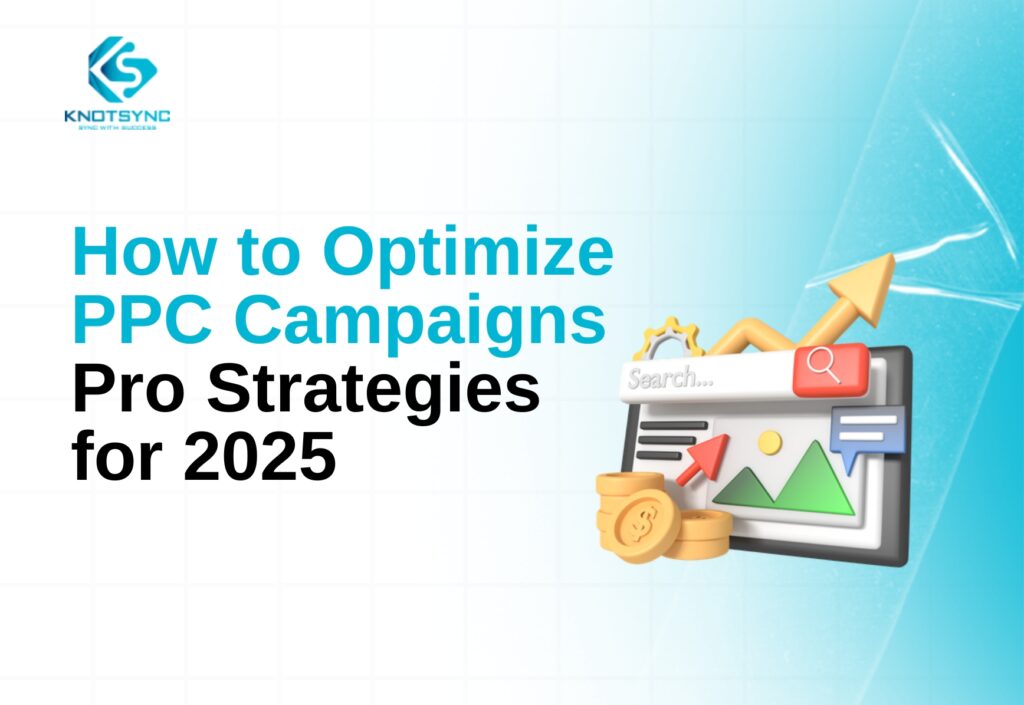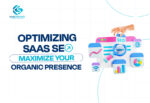Table Of Content:
1. Why PPC Campaign Optimization Matters in 2025?
2. What’s the Best PPC Optimization Strategy for 2025?
- Negative Keyword Strategy
- Upgrade Your Ad Creative
- Bidding Management Techniques
- Fix Your Landing Pages For Better Conversions
- Automation & AI Tools
3. Frequently Asked Questions (FAQs)
4. Conclusion
5. Key Takeaways
Have you ever looked at your ad budget and thought, “Wait… where did all my money go?”
Yeah, same.
PPC can feel like a money pit if you don’t manage it properly. You set your ads and watch the clicks roll in, but when you check your ROI, you’re not sure where your budget went.
In 2025, PPC isn’t the wild west it used to be; clicks are getting pricier, algorithms are getting smarter, and competition is tougher. If you’re still running campaigns the same way you did two years ago, chances are you’re burning cash without realizing it.
That’s where PPC optimization comes in. It’s not about spending more – it’s about spending smarter. It can still be one of the highest-ROI marketing channels, if you know how to tweak your campaigns, control bids, and align your ads with the right audience.
This blog will be your step-by-step guide to master PPC optimization in 2025, from smarter keyword strategies to landing page fixes to campaign automation that saves hours.
Let’s dive straight into it!
Why PPC Campaign Optimization Matters in 2025?
Search ads, display ads, and social ads are all getting more and more competitive. CPCs keep creeping up every year, which means if you’re not actively optimizing, then you’re literally paying for wasted clicks.
And this isn’t slowing down anytime soon. According to Dentsu’s mid-year Global Ad Spend Forecasts report, worldwide digital ad spend is on track to hit $678.7 billion in 2025. That means more advertisers fighting for the same audience, and less margin for sloppy campaigns.
Here’s what happens when you don’t optimize:
-
-
- You overspend on irrelevant clicks. If you’re not actively reviewing your campaigns, then you’re paying for clicks that will never turn into sales or leads.
-
- Your competitors are optimizing. Which means they’re often paying less per click, showing up more often, and stealing the audience you’re trying to reach.
-
- “Set and forget” campaigns are officially dead. The days of throwing up a few ads and letting them run for months without touching them are long gone. Platforms reward advertisers who are constantly testing, refining, and improving.
-
Learning how to optimize PPC campaigns gives you three wins:
-
-
- Better Quality Scores – lower CPCs and better ad placements.
-
- Higher Conversion Rates – because your ads and landing pages match what people actually want.
-
- Faster Learning – the more you tweak, the more data you get back, and the smarter your next move becomes.
-
So, if you want to optimize your PPC campaign, then this guide is going to show you exactly how to do all of that – step by step.
What’s the Best PPC Optimization Strategy for 2025?
With new technologies, privacy regulations, and shifting search, the old rules of paid advertising no longer apply.
If you’re looking to cut through the noise and achieve a higher ROI on your ad spend then you need a strategy that is built for the future. The strategies below will define PPC success in 2025.
1. Negative Keyword Strategy
Negative keywords are one of the powerful ways to protect your PPC budget. They help in prevent your ads from showing for searches that aren’t relevant to your product or service. Using them effectively means:
-
-
- Fewer wasted clicks
-
- Better ROI
-
- Accurate performance data
-
Follow this step-by-step guide on negative keyword strategy:
1. Audit Your Search Term Report Weekly
The first step is understanding which queries are actually triggering your ads. Look at your search term report every week to identify:
-
-
- Irrelevant queries that have nothing to do with your offering.
-
- Low-converting keywords that bring clicks but rarely lead to sales or leads.
-
Regular audits ensure you’re constantly trimming waste and focusing only on terms that drive results.
2. Add Negatives at the Right Level
Placement of negative keyword is really important:
| Level | When to Use | Example |
| Campaign | Broad negatives that should never trigger any ad in the campaign | “Free,” “Cheap” |
| Ad Group | Targeted negatives for specific ad groups | “Trial” for one product line but not another |
Pro Tip: Adding negatives incorrectly can accidentally block valuable traffic. Always double-check placement.
3. Use Match Types Strategically
Negative keywords can be added in different match types to control how broadly they block searches:
-
-
- Broad Match Negatives: Blocks any search containing the word/phrase, even if the query is slightly different. Useful for very generic terms.
-
- Phrase Match Negatives: Blocks searches containing the exact phrase in the same order. Useful for more controlled blocking.
-
- Exact Match Negatives: Blocks only the exact search query. Use this for precise filtering of specific problem keywords.
-
4. Build and Maintain a Master List
Create a master negative keyword list to save time and maintain consistency across campaigns. Include:
-
-
- Add Common irrelevant terms (for example “free,” “jobs,” “DIY,” “samples”).
-
- Competitor brand names, if you don’t want to target competitor traffic.
-
This list can be reused across different campaigns and updated regularly.
2. Upgrade Your Ad Creative
Ad fatigue is real, and it’s a silent budget killer because nowadays people scroll faster, have shorter attention spans, and have seen every generic ad out there. If your ads are not creative enough for the people to stop scrolling, then they will be ignored, your CTR will tank, and your CPCs will climb.
Here’s a solid rule of thumb for your ad copy:
-
-
- Refresh your ad creatives every 4-6 weeks for high-volume campaigns and
-
- Every 8-10 weeks for lower-volume ones.
-
It’s important that you continuously test new headline styles, descriptions, images, and video formats.
Here’s a quick example of a simple ad copy refresh:
| Before (Bland) | After (Creative) |
| Best CRM Software | Boost Sales 30% with [Your Brand] CRM Software |
| Manage Customer Leads | Automate Lead Scoring & Follow-Ups |
| Our CRM Helps You Grow | Stop missing leads. Try free for 14 days – see results fast! |
And don’t forget the text. Visuals can make or break your campaigns. Use scroll-stopping images, short videos, and a mobile-first design that grabs attention instantly.
You can also use platforms like Midjourney or DALL-E 3 to generate stunning visuals that are tailored to your brand and campaign message in minutes.
3. Bidding Management Techniques
Bidding is the heart of PPC. Get it wrong, and you either blow through your budget or fail to get enough impressions.
If you’re manually adjusting bids for hundreds or thousands of keywords across multiple campaigns, then you’re wasting a lot of time that you could use for something else.
Automated bidding strategies like Target CPA and Target ROAS can optimize better and faster by using real-time signals like devices, location, and time of day.
Let’s look at the difference between Manual and Automate bidding so that you can understand which option is better for you.
| Feature | Manual Bidding (Old Way) | Smart Bidding (2025 Way) |
| Control | You set bids keyword by keyword, ad group by ad group. | You set a goal (like Target CPA or ROAS) and the system adjusts bids for you. |
| Optimization Signals | You look at a few signals like device or time of day. | It uses thousands of real-time signals (context, user behavior, etc.) every time someone searches. |
| Time Investment | Lots of daily tweaks and manual work. | Minimal – you just monitor and guide strategy. |
| Accuracy | Easy to make mistakes or miss opportunities. | Super precise, adjusts bids in real time. |
| Scalability | Hard to manage if you have a lot of campaigns. | Works beautifully even with massive accounts. |
| Best For | Good for very niche or super-low-volume keywords. | Best for almost all campaigns with enough conversion data. |
Smart PPC Bid Management Techniques in 2025
Getting the most out of smart bidding isn’t just about switching it on; you need to guide it strategically. These techniques will help you work with the algorithm instead of against it, so you get better performance with less stress.
-
-
- Start with the Right Goal: Choose tCPA or tROAS based on whether you care more about campaign volume, overall conversions, or long-term profitability.
-
- Feed the Algorithm Quality Data: Set up proper conversion tracking, accurate event tagging, and reliable data sources; without clean data, optimization will fail.
-
- Give It Enough Time: Allow at least 1-2 weeks for the algorithm to exit the learning phase before making any adjustments, so it can properly understand performance patterns.
-
- Monitor, Don’t Micromanage: Review performance at a high-level weekly, focus on trends and strategy, and resist the urge to optimize every single click or keyword individually.
-
4. Fix Your Landing Pages For Better Conversions
A killer ad can’t save a bad landing page. If your page is slow, confusing, or hard to use on mobile, then this means a high bounce rate and wasted ad spend. A high-converting landing page is non-negotiable in 2025.
Key Elements of a High-Converting Landing Page:
-
-
- Fast Speed: Your landing page must load in 2 seconds or less. Accoding to Big commerce, every extra second can reduce conversions by up to 7%. Use tools like Google PageSpeed Insights to continuously monitor and improve performance.
-
- Mobile-First Design: With the majority of clicks coming from smartphones, your landing page should be fully responsive, easy to navigate, and readable without zooming or scrolling horizontally.
-
- Clear and Compelling Headline: Your headline should immediately tell the ad’s message, clearly communicate the value proposition, and grab attention. Dynamic keyword insertion can make it even more relevant.
-
- Concise and Benefit-Oriented Copy: Focus on how your product or service solves the user’s problem. Use short paragraphs and bullet points, and avoid overwhelming the visitor with too much text.
-
- Clear Call-to-Action (CTA): Place it above the fold and use action-oriented language like “Get My Free Quote,” “Download Now,” or “Start Your Trial.” Make it visually distinct with color and size.
-
Making a good landing page that has all the above elements is difficult, but you can use this ChatGPT prompt to create a high-converting landing page:
Write a [type of asset: landing page, LinkedIn post, homepage, email, ad, etc.] for [audience / buyer persona] about [your product/service/offer].
Use the 3-step formula below:
-
-
- What do I get?
-
- Lead with a strong benefit that directly improves the audience’s work, results, or reputation.
-
- Be specific (e.g., hours saved, revenue gained, risk avoided, career win).
-
- Keep it short, bold, and outcomes driven.
- How can I use it?
-
- Give 2–3 clear use cases or mini-stories showing how people like them already apply it.
-
- Make it easy for them to imagine themselves succeeding with it.
-
- Avoid feature lists — focus on scenarios.
- Why should I believe you?
-
- Anticipate objections (integration, onboarding, budget, credibility).
-
- Weave in proof: data, customer logos, testimonials, pricing anchors, or speed of results.
-
Style notes:
-
-
- Tone = [insert: conversational, sharp, witty, authoritative, approachable, etc.]
-
- Length = [insert: short LinkedIn post, 200-word landing page, headline + subhead, etc.]
-
- Call to Action = [insert: book demo, try free, download guide, join waitlist, etc.
-
5. Automation & AI Tools
Automation and intelligent tools are changing the game of PPC campaigns. These tools aren’t just nice-to-haves anymore; they’re essential if you want to scale your campaigns without losing your mind.
If you use them correctly, then they can save your time, reduce errors, and let you focus on strategy rather than micro-managing every click.
PPC Automation Best Practices
-
-
- Scheduled Rules: Set up rules to pause underperforming keywords, adjust bids at certain times of day, or increase spend during peak hours. Tools like Google Ads rules or scripts can automate these adjustments.
-
- Automated Reporting: Use dashboards in Google Data Studio or Looker Studio to track campaign performance in real-time. You can schedule automated reports to be emailed to your team daily, weekly, or monthly.
-
Smart Tools and AI in PPC Optimization
-
-
- Responsive Search Ads: Platforms like Google Ads can automatically test different headline and description combinations, choosing the best-performing variations based on real-time data.
-
- Performance Max Campaigns: AI-driven campaigns handle targeting across Search, Display, YouTube, and Gmail automatically. Providing high-quality creative assets and clear conversion goals ensures the system performs optimally.
-
- Predictive Bidding: AI adjusts bids based on hundreds of signals such as device, location, time, user behavior, and historical performance.
-
Using Generative Tools for PPC
Generative tools can streamline ideation and testing for ad copy and landing pages. Use ChatGPT or similar platforms to produce creative options quickly.
-
-
- Headline Variations: Generate 10+ headline ideas and test the top performers. Prompt example for ChatGPT or any other tool: Generate 10 compelling ad headlines for a SaaS productivity tool targeting small businesses.
-
- Ad Copy Personalization: Quickly create versions tailored to different audience segments. Prompt example: Write 3 personalized ad copy variations for mid-sized companies looking for project management software.
-
- Landing Page Suggestions: Use AI to analyze competitor pages and identify UX or content improvements. To do this you can give ChatGPT this prompt: Analyze competitor landing pages for productivity tools and suggest 5 ways to improve conversions on our page.
-
Important: Always make sure that you review AI-generated answers to ensure it matches your brand voice and is factually accurate. These tools should assist your workflow, not replace human judgment.
Frequently Asked Questions (FAQs)
So, in the above section, we have covered PPC campaigns in detail. To make things even clearer for you, we’ve put together some answers to the most common questions that people have online:
1. Which AI automation tools give the biggest PPC ROI in 2025?
The best tools are those that automate the most time-consuming tasks like bid management, ad copy creation, and keyword research.
Tools like Optmyzr, Skai, and Adalysis are popular choices because they use AI to optimize campaigns across multiple platforms, leading to better returns.
2. How should you adapt bidding for voice and visual search traffic?
For these new search types, focus on conversational, natural-language keywords. Also, optimize for local search queries and ensure your ads use high-quality images and video.
The best strategy is to rely on smart bidding, as Google’s AI is designed to understand the context of these new searches.
3. Which platforms beyond Google should you expand PPC spend to in 2025?
Diversifying your ad spend is a great idea. Consider Microsoft Advertising for a professional audience, Amazon for e-commerce, and Meta Ads for brand awareness and social targeting.
If you’re a B2B business, LinkedIn Ads offers powerful targeting by job title and industry.
Conclusion
In 2025, optimizing your PPC campaigns is all about working smarter, not harder. By focusing on the right keywords, refreshing ad creatives, managing bids effectively, and improving landing pages, you can get more conversions and better results from every dollar spent.
And if you find these things complicated, you should reach out to a professional PPC specialist like Knotsync.
We can handle all this for you, from keyword research to creative testing to analytics setup, so that you can start scaling.
Key Takeaways
-
- Let automation & AI handle bids so that you can handle strategy. Your role shifts from micro-managing to strategic oversight and feeding the system quality inputs.
-
- Refresh creatives every 4–6 weeks. Use AI tools to generate new visuals and copy variants efficiently.
-
- Nail your negative keyword strategy. Continuously refine your negative keyword lists to prevent wasted spend and improve targeting accuracy.
-
- Optimize your landing pages. A perfect ad is useless without a fast, relevant, mobile-first landing page designed for conversion.




